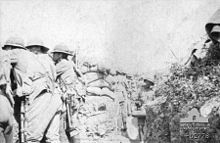9th Light Horse Regiment (Australia)
| 9th Light Horse Regiment | |
|---|---|
First World War
| |
| Insignia | |
Unit colour patch |  |
The 9th Light Horse Regiment was a
During the inter-war years, the regiment was re-raised as a part-time unit based in
Formation
The 9th Light Horse Regiment was raised at
All
Operational history
Gallipoli campaign

In February 1915, the 9th Light Horse Regiment left Melbourne for Egypt, arriving on the 1 February 1915.
Sinai and Palestine campaign

On the regiment's return to Egypt, together with the 3rd Light Horse Brigade, they were assigned to the newly raised
In December 1916, the regiment took part in a
The next
Perpetuation
In 1921, Australia's part-time military forces were re-organised to perpetuate the numerical designations of the AIF following its demobilisation.[8] Through this process, the 9th Light Horse was re-raised as a Citizens Forces unit within the 4th Military District in the state of South Australia, drawing lineage from the 24th Light Horse (Flinders), which had been formed in 1913 and which traced its origins back to the 17th Australian Light Horse Regiment that had been formed in 1903 as part of the amalgamation of Australia's colonial forces into the Australian Army after Federation.[9]
Later, this unit was amalgamated with the
In the post war period, Australia's part-time force was re-raised and in 1949 the regiment was reformed as an amalgamated unit with the 3rd Light Horse Regiment, adopting the designation of the 3rd/9th Light Horse (South Australian Mounted Rifles).[11]
Battle honours
The 9th Light Horse Regiment was awarded the following battle honours:
- Palestine 1917–1918.[1]
Commanding officers
The following officers commanded the 9th Light Horse Regiment during the First World War:
- Lieutenant Colonel Carew Reynell (KIA)[7]
- Lieutenant Colonel William Grant DSO[12]
- Lieutenant Colonel John McLean Arnott CMG[13]
- Lieutenant Colonel William Henry Scott CMG, DSO & Bar[14]
- Lieutenant Colonel Thomas Joseph Daly DSO[15]
References
- Citations
- ^ a b c d e f g h i "9th Light Horse Regiment". First World War, 1914–1918 units. Australian War Memorial. Retrieved 29 November 2011.
- ^ Gullett 1941, p. 54.
- ^ Horner and Williams, Chapter: Setting up the Light Horse
- ^ Gullett 1941, p. 29.
- ^ Gullett 1941, p. 38.
- ^ a b "Lieutenant Colonel Albert Miell, MID". Australian War Memorial. Retrieved 18 December 2011.
- ^ a b "Lieutenant Colonel Carew Reynell, MID". Australian War Memorial. Retrieved 18 December 2011.
- ^ Grey 2008, p. 125.
- ^ a b c Festberg 1972, p. 45.
- ^ Finlayson 2012, p. 200.
- ^ Festberg 1972, p. 15.
- ^ "Brigadier General William Grant, CMG, DSO (Bar), MID". Australian War Memorial. Retrieved 18 December 2011.
- ^ "Lieutenant Colonel John McLean Arnott, CMG". Australian War Memorial. Retrieved 18 December 2011.
- ^ "Colonel William Henry Scott, CMG, DSO and Bar". Australian War Memorial. Retrieved 18 December 2011.
- ^ "Lieutenant Colonel Thomas Joseph Daly". Australian War Memorial. Retrieved 18 December 2011.
- Bibliography
- Festberg, Alfred (1972). The Lineage of the Australian Army. Melbourne, Victoria: Allara Publishing. ISBN 978-0-85887-024-6.
- Finlayson, David (2012). Green Fields Beyond. Canberra, Australian Capital Territory: Department of Veterans' Affairs. OCLC 799180097.
- ISBN 978-0-521-69791-0.
- OCLC 220901683.
- ISBN 978-1-74246-894-5.
Further reading
- Darley, T.H. (1924). With the Ninth Light Horse in the Great War. Adelaide, South Australia: The Hassell Press. OCLC 35122664.
